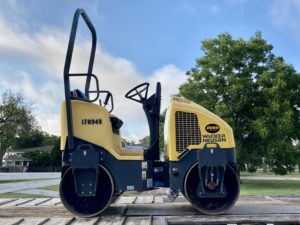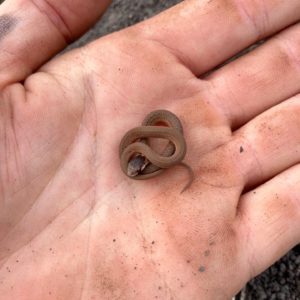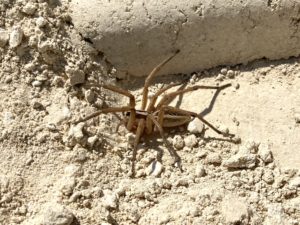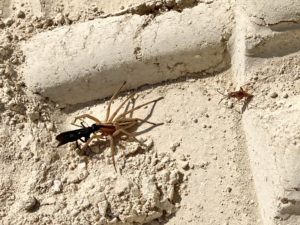These past two weeks, I have been building the walking trail for the Partners project, a Blackland Prairie nature education site currently in development on the farm. I rented a track skid steer and have been operating it to excavate the trail, entrance clearing, and prairie pothole features. Following excavation, I laid down a geotextile fabric to prevent vegetation from growing up through the trail aggregate and to reduce erosion and loss of aggregate over time. While I was excavating, the aggregate was delivered via trucks to designated intervals along the trail route, for 12 loads totaling approximately 295 tons of 3/8” crushed limestone, including fines. It was very interesting to see how those trucks operated in terms of unloading their cargo (see photo). Once I had the aggregate, I began to ferry bucketfuls from the aggregate piles to the trail and then began spreading the aggregate out using the bucket float feature on the trackskid. I have really enjoyed operating the trackskid; it’s a neat piece of equipment, both versatile and maneuverable, and the tracks are more stable on the uneven ground than the four wheels of a regular skid steer. Ear protection is a must though, as the thing is a rattle trap.
My next steps involve saturating the trail with water, shaping it further with the trackskid to create a shallow crown in the middle of the trail to divert precipitation, and then using a double-drum vibratory roller to compact the trail so that it is ready for traversing by the feet of many. I also have some additional dirt work to do along and around the trail, such as building small berms and excavating shallow channels, as a way to hopefully further mitigate impacts from erosion caused by future precipitation and runoff.
In other news, our LIP (Landowner Incentive Program) project area received an herbicide application last week, following the clearing of mesquite, in preparation for planting native grasses and forbs early next year. It is wonderful to see that project moving forward as well. We’ve planted approximately 50 acres of natives this past year between our two PUB (Pastures for Upland Birds) project areas, and between Partners and LIP, we should have another 100 acres planted in the next year or two. Even after my time here comes to a close, I plan to return to see the natives established in these project areas, as it will be a beautiful sight.
While excavating in Partners, I came across a new reptile to add to the farm’s species roster: a Dekay’s brownsnake (Storeria dekayi)! This juvenile was crossing the cleared ground and so was visible to me, but it was definitely the tiniest individual snake I have ever come across. The Dekay’s brownsnake is a small native non-venomous snake that primarily feeds on snails, slugs, and earthworms. Adults give birth to live young in late summer, and I expect this little one was very new to the world. It is heartening to find another reptile species in the Partners project area, and I am hopeful the upcoming native grassland restoration efforts will provide improved habitat for brownsnakes and other native wildlife to flourish.
As another interesting find, I observed a spider wasp (Family Pompilidae) dragging a paralyzed rabid wolf spider (Rabidosa rabida) across the trail. I was able to watch the drama unfold as a smaller spider wasp of a different species, likely Ceropales elegans elegans, approached and investigated the larger wasp’s prize. Ceropales species are known to be kleptoparasitic, meaning their foraging strategies usually involve stealing prey from other wasps. Additionally, Ceropales spp. will often intercept other female solitary wasps as they drag their spider prey back to their nests and the Ceropales female will scare off the other female and insert an egg into the paralyzed spider before departing. That appears to be what this individual did. The other spider wasp will often return to continue dragging its prey back as a source of food for offspring, unaware that the meal is already host to the Ceropales egg. As soon as the Ceropales larvae hatches, it will seek out the egg of the other wasp and consume it before preying on the spider host. Fittingly, the common name of this genus in some countries is the ‘cuckoo spider wasp.’ Unfortunately for the spider, it will be the ultimate loser in this battle of wills.
I should have photos of the completed trail installation, save a few bridges, for my next post.
Until then,
Dani Miller
Wildlife Biologist
Texas A&M AgriLife Extension Service
Stiles Farm Foundation








